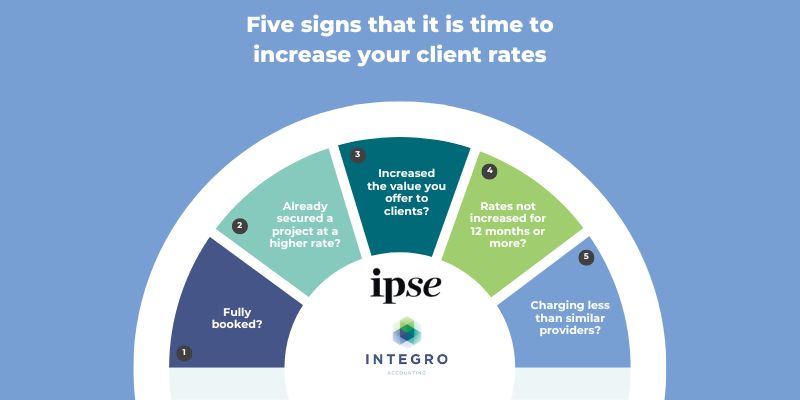Increase your rates – A quick guide by IPSE
30th July 2024

If you are wondering whether to increase your rates or how to review your pricing policy, this quick guide from IPSE is the perfect place to start.
For a closer look at how any increase in rates will affect your business and personal finances you can get in touch with one of our experienced accountants, who will be happy to guide and help you, using our contact details page or drop us a call back request here.
A quick guide to raising your client rates by IPSE
If you’re a self-employed individual, chances are you set your own prices and rates for the work that you do.
If you haven’t increased your rates in a while (or perhaps even since becoming self-employed), you’re probably due a review of your prices or even your pricing structure as a whole. You might be missing out on valuable income if you don’t.
Understanding how to raise your client rates will reflect your growing skills and experience, or any new services you’ve added. It will also help you cope with inflation or will balance things out if your own costs are increasing.
Below we’ll outline some signs that may indicate it’s time to increase your rates, how to check your rates against industry standards, and how to justify and communicate your rate increase to clients.
Are you due a rate increase?
Whilst you don’t necessarily need a particular reason to increase your rates, there are definitely signs that indicate it could be time to do so. Keep an eye out for one or more of the following:
- You’re currently fully-booked, and turning away business
- You’ve already secured one or more projects at a higher rate
- You’ve increased the value you offer to clients
- You haven’t increased your rates in 12 months or more
- You’re charging less than similar providers
If you believe you can justify the higher cost to current or new clients and secure the right amount of projects, then you’ve made the right decision.
How do your rates compare to industry averages?
There are a range of ways to check the average income in your sector, including our IPSE Freelancer Confidence Index and Self-Employed Landscape reports. For a limited time, you can also download our 2024 Average Day Rates guide for free.
Various employment sites also list the average salary for various freelance roles, based on submissions from their registered visitors. Plus, specialist trade bodies may also publish rate cards.
IPSE members can access the Guide to Setting Rates, which also includes a list of standard freelance rates based on research and the input of the IPSE community.
Important: Remember that the rates suggested will depend on various factors, including the skills and experience required, location, industry trends and more.
Getting involved in the IPSE community, local groups and building up your network will also help you discover whether you’re achieving the correct rewards for your efforts.
How to justify and communicate higher rates
Whether you’re negotiating with existing clients or pitching to new ones, it’s important to consider how you’ll justify your new rates and communicate your value.
With existing clients, it’s useful to re-examine your original contract and see if the scope of work has expanded or changed over time. It’s possible that you’ve agreed to an increasing number of tasks over the course of your relationship and/or been using more than the allotted hours. Use evidence of the projects and results you’ve delivered to demonstrate your value.
Another option is to reposition how your business works with a client. Switching from an hourly or day rate to project-based pricing could allow you to earn more for your time.
You’ll need to plan your rate increase in advance, and let clients know in appropriate time so as not to annoy them. Between two or three months’ notice not only allows them time to respond, but also gives you the chance to replace anyone who doesn’t want to continue the relationship with your new prices.
It’s important to allow clients the opportunity to potentially negotiate or take up other options. You may decide to accept a lower amount to continue with a client or project you enjoy, or to continue at a lower rate by working less hours.
In every case, the important factor in securing higher rates will be that the client feels that they’re going to get more value from your relationship as a result.
Read our advice on raising rates for more information on ways to justify your increase and how to formulate your communications to clients.
Taking your self-employed business to the next level
For even more advice on growing your self-employed business, be sure to check out our website (particularly the growth hub!).
